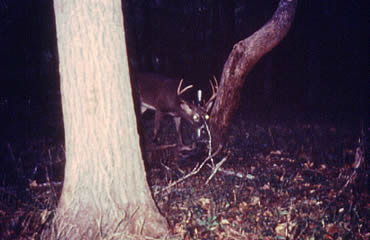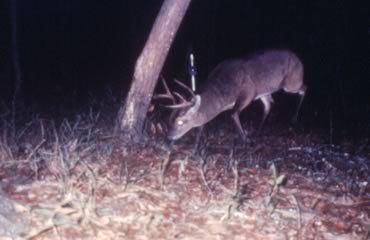By C.J. Winand
Not all rubs are created equal. Here’s how to determine which you should pay attention to.
Are rubs the key to hunting the rut? Are there different types of rubs? What behaviors do bucks exhibit at rub sites? Do bucks prefer certain types of trees for making rubs? Most hunters have more questions than answers when it comes to buck rubs.
Years ago, noted deer biologist Grant Woods completed his Ph.D. work at Clemson University in South Carolina. Woods’ dissertation set the standard and addressed the physical characteristics of traditional rubs and associated whitetail behavior. He defined a traditional rub as any species of tree that had been rubbed for at least three consecutive years and is 3 inches or more in diameter. A buck rub that does not meet these criteria is classified as non-traditional.
For two years — from Aug. 15 to Jan. 1 — Woods used nine infrared game cameras to monitor deer behavior at traditional rub sites. At the same time, he ran various transect lines to observe 186 non-traditional rubs. Woods photographed 379 occurrences at his nine traditional rub sites. Based on those photographs, Woods discovered that more than half of all traditional rubs occurred on sassafras, Southern magnolia and Eastern red cedar. That’s significant considering that these aromatic tress comprised only 4 percent of the forest population.
Non-traditional rubs occurred predominantly on sweet leaf, wax myrtle and eastern red cedar. Those trees made up less than 5 percent of the woody plants in the area. Once again, white-tailed bucks preferred aromatic trees. It’s interesting to note that bucks in the study preferred the sassafras more than any other tree.
So how do you find traditional rubs?
Woods says that traditional rubs are generally located in areas with at least 80 yards of unobstructed visibility. Apparently, bucks want to maximize the effectiveness of their work by creating rubs in relatively open areas. Thus, if you have good field notes from previous years and do a little extra scouting in open areas, traditional rubs are not difficult to locate.
 The number one question hunters want to know is, “When do bucks visit rubs the most?” Overall, most deer visit rubs at night. For example, 74 percent of all bucks, 60 percent of does and 51 percent of fawns were photographed between 9 p.m. and 6 a.m. In the entire Woods study, only one mature buck was photographed during daylight hours, and that was early — 7:39 a.m.
The number one question hunters want to know is, “When do bucks visit rubs the most?” Overall, most deer visit rubs at night. For example, 74 percent of all bucks, 60 percent of does and 51 percent of fawns were photographed between 9 p.m. and 6 a.m. In the entire Woods study, only one mature buck was photographed during daylight hours, and that was early — 7:39 a.m.
While that’s not encouraging, I should point out that the study area was hunted hard, and activity just beyond the infrared cameras could have varied substantially. Night visits might have been in response to deer modifying their daily movements to avoid hunters and researchers.
Pen studies have shown that bucks commonly rub in broad daylight. Either way, it’s reasonable to assume that hunters in areas with low hunting pressure can expect more bucks to rub during daylight hours than those in high-pressure locations.
Woods learned that buck activity around traditional rubs was strongly associated with the first deer conception dates. In fact, buck activity around traditional rubs increased during the rut. This contradicts previous studies that indicated rub activity preceded the first breeding. Since this work was conducted under a quality deer management program, I believe the difference in herd composition and social biology probably account for this discrepancy.
Woods noted that bucks with five or more antler points rubbed earlier than bucks with four or fewer points. In fact, some biologists believe that when mature bucks rub earlier, they deposit a priming pheromone that might synchronize breeding cycles, bringing does into estrus earlier and suppressing testosterone in smaller bucks. Thus, yearling bucks in the presence of mature bucks do not rub as much as mature bucks in the same area.
Re-use of existing rubs has always interested hunters and biologists. Some believe that every time a buck checks a traditional rub, it wants to establish dominance by re-rubbing. Woods found six of the nine traditional rubs experienced some reuse. One buck was photographed at six of the nine traditional rub sites during one year. One traditional rub had at least 13 different bucks photographed. Woods estimated that nine of the bucks were more than 11¼2 years old. Apparently, mature bucks are more likely to work a traditional rub than yearling bucks.
 I always wondered what percentage of re-use there is on non-traditional rubs (less than 3 inches in diameter). Using a pencil lead to mark existing non-traditional rubs, my own field experience has indicated the number is very low. This information suggests that hunters should focus on traditional rubs and plot them on a map. Woods agrees. His data suggest older bucks will re-rub traditional buck rubs and forgo re-rubbing non-traditional ones.
I always wondered what percentage of re-use there is on non-traditional rubs (less than 3 inches in diameter). Using a pencil lead to mark existing non-traditional rubs, my own field experience has indicated the number is very low. This information suggests that hunters should focus on traditional rubs and plot them on a map. Woods agrees. His data suggest older bucks will re-rub traditional buck rubs and forgo re-rubbing non-traditional ones.
Woods’ photos showed that bucks, does and fawns all addressed rubs. Not surprisingly, bucks were most likely to exhibit a behavior, and only one fawn actively addressed a rub. When they did react, deer exhibited one or more of six specific behaviors: antler touch, forehead touch, body touch, smelling, rubbing and butt-touch.
Although I have never witnessed the butt-touch behavior, it involves a deer literally rubbing its posterior against a rub. Some biologists believe deer might have an as-yet-unidentified rump gland that deposits a chemical signal on the rub. This is true for certain African species that mark their territories with an anal gland.
As the last behavior indicates, we still have some things to learn about why whitetails do what they do at rubs. In the meantime, I’m going to focus my hunting efforts on traditional rubs on trees of 3 or more inches in diameter and will probably use some other deer sign as a focus in high-pressure areas. Does that mean you’ll never take a deer over a small rub in the daylight? I’m sure it happens now and then, but Woods’ information says the odds are against it.
Read Recent Articles: • Lessons Learnt: Following are a few pearls of wisdom from a professional deer manager and hunter.
• Counting Points: Do state-mandated antler restrictions make a positive impact on herd health?
• No Second Thoughts: Some say taking an albino deer is bad luck, but this hunter didn’t even think twice.
This article was published in the Winter 2008 edition of Buckmasters Whitetail Magazine. Join today to have Buckmasters delivered to your home.